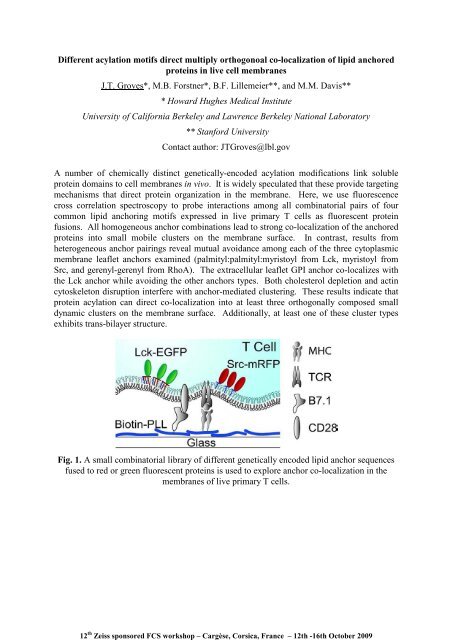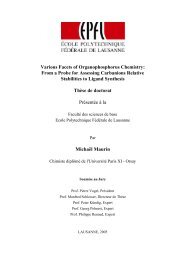12th Carl Zeiss sponsored workshop on ... - Institut Fresnel
12th Carl Zeiss sponsored workshop on ... - Institut Fresnel
12th Carl Zeiss sponsored workshop on ... - Institut Fresnel
Create successful ePaper yourself
Turn your PDF publications into a flip-book with our unique Google optimized e-Paper software.
Different acylati<strong>on</strong> motifs direct multiply orthog<strong>on</strong>oal co-localizati<strong>on</strong> of lipid anchored<br />
proteins in live cell membranes<br />
J.T. Groves*, M.B. Forstner*, B.F. Lillemeier**, and M.M. Davis**<br />
* Howard Hughes Medical <strong>Institut</strong>e<br />
University of California Berkeley and Lawrence Berkeley Nati<strong>on</strong>al Laboratory<br />
** Stanford University<br />
C<strong>on</strong>tact author: JTGroves@lbl.gov<br />
A number of chemically distinct genetically-encoded acylati<strong>on</strong> modificati<strong>on</strong>s link soluble<br />
protein domains to cell membranes in vivo. It is widely speculated that these provide targeting<br />
mechanisms that direct protein organizati<strong>on</strong> in the membrane. Here, we use fluorescence<br />
cross correlati<strong>on</strong> spectroscopy to probe interacti<strong>on</strong>s am<strong>on</strong>g all combinatorial pairs of four<br />
comm<strong>on</strong> lipid anchoring motifs expressed in live primary T cells as fluorescent protein<br />
fusi<strong>on</strong>s. All homogeneous anchor combinati<strong>on</strong>s lead to str<strong>on</strong>g co-localizati<strong>on</strong> of the anchored<br />
proteins into small mobile clusters <strong>on</strong> the membrane surface. In c<strong>on</strong>trast, results from<br />
heterogeneous anchor pairings reveal mutual avoidance am<strong>on</strong>g each of the three cytoplasmic<br />
membrane leaflet anchors examined (palmityl:palmityl:myristoyl from Lck, myristoyl from<br />
Src, and gerenyl-gerenyl from RhoA). The extracellular leaflet GPI anchor co-localizes with<br />
the Lck anchor while avoiding the other anchors types. Both cholesterol depleti<strong>on</strong> and actin<br />
cytoskelet<strong>on</strong> disrupti<strong>on</strong> interfere with anchor-mediated clustering. These results indicate that<br />
protein acylati<strong>on</strong> can direct co-localizati<strong>on</strong> into at least three orthog<strong>on</strong>ally composed small<br />
dynamic clusters <strong>on</strong> the membrane surface. Additi<strong>on</strong>ally, at least <strong>on</strong>e of these cluster types<br />
exhibits trans-bilayer structure.<br />
Fig. 1. A small combinatorial library of different genetically encoded lipid anchor sequences<br />
fused to red or green fluorescent proteins is used to explore anchor co-localizati<strong>on</strong> in the<br />
membranes of live primary T cells.<br />
12 th <str<strong>on</strong>g>Zeiss</str<strong>on</strong>g> <str<strong>on</strong>g>sp<strong>on</strong>sored</str<strong>on</strong>g> FCS <str<strong>on</strong>g>workshop</str<strong>on</strong>g> – Cargèse, Corsica, France – <str<strong>on</strong>g>12th</str<strong>on</strong>g> -16th October 2009













